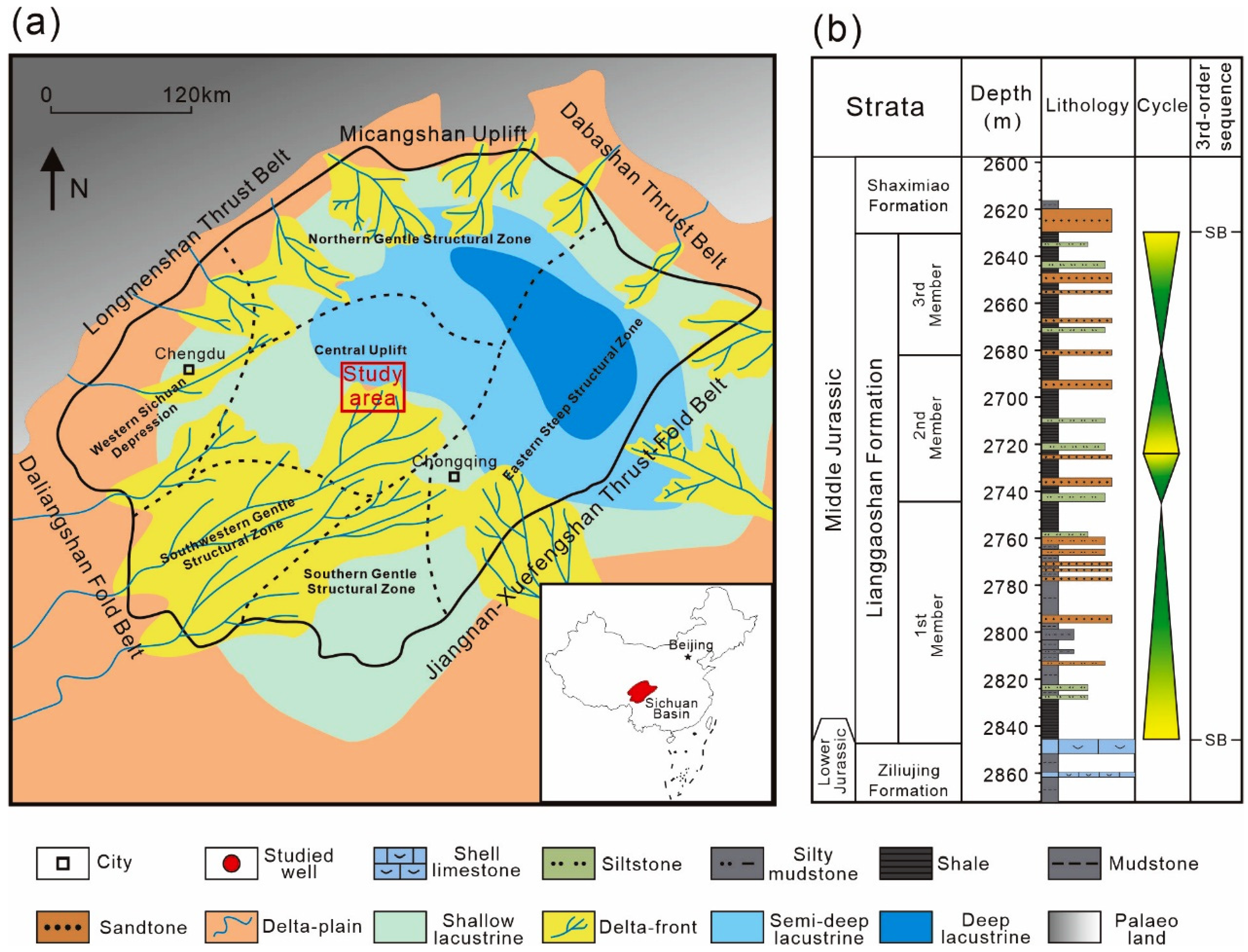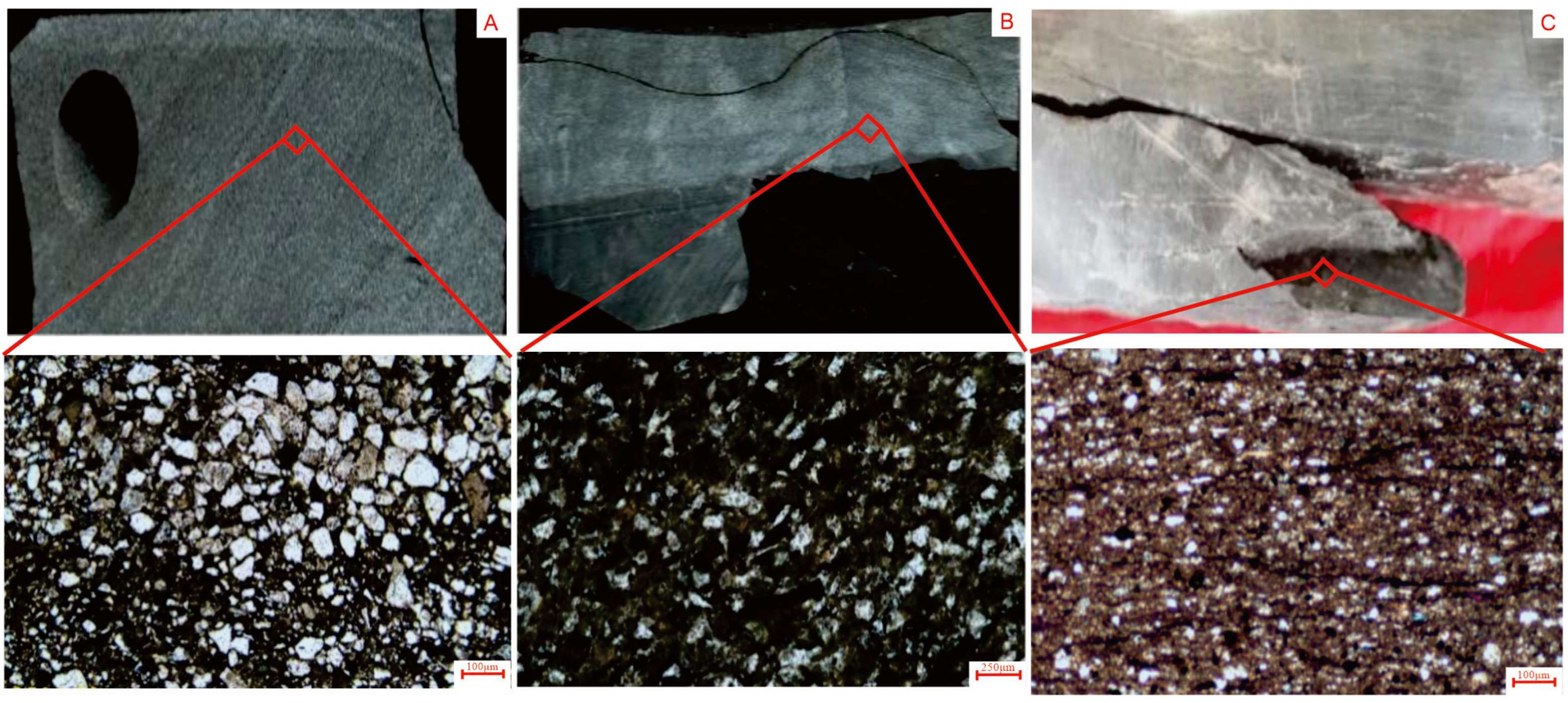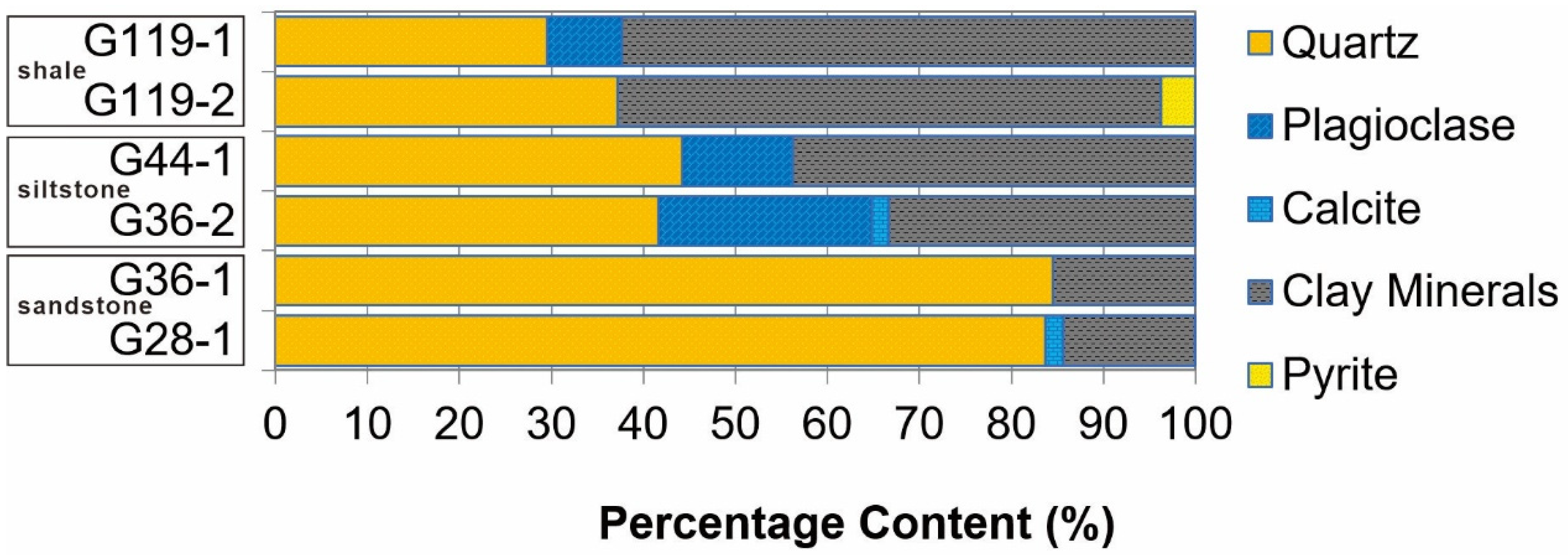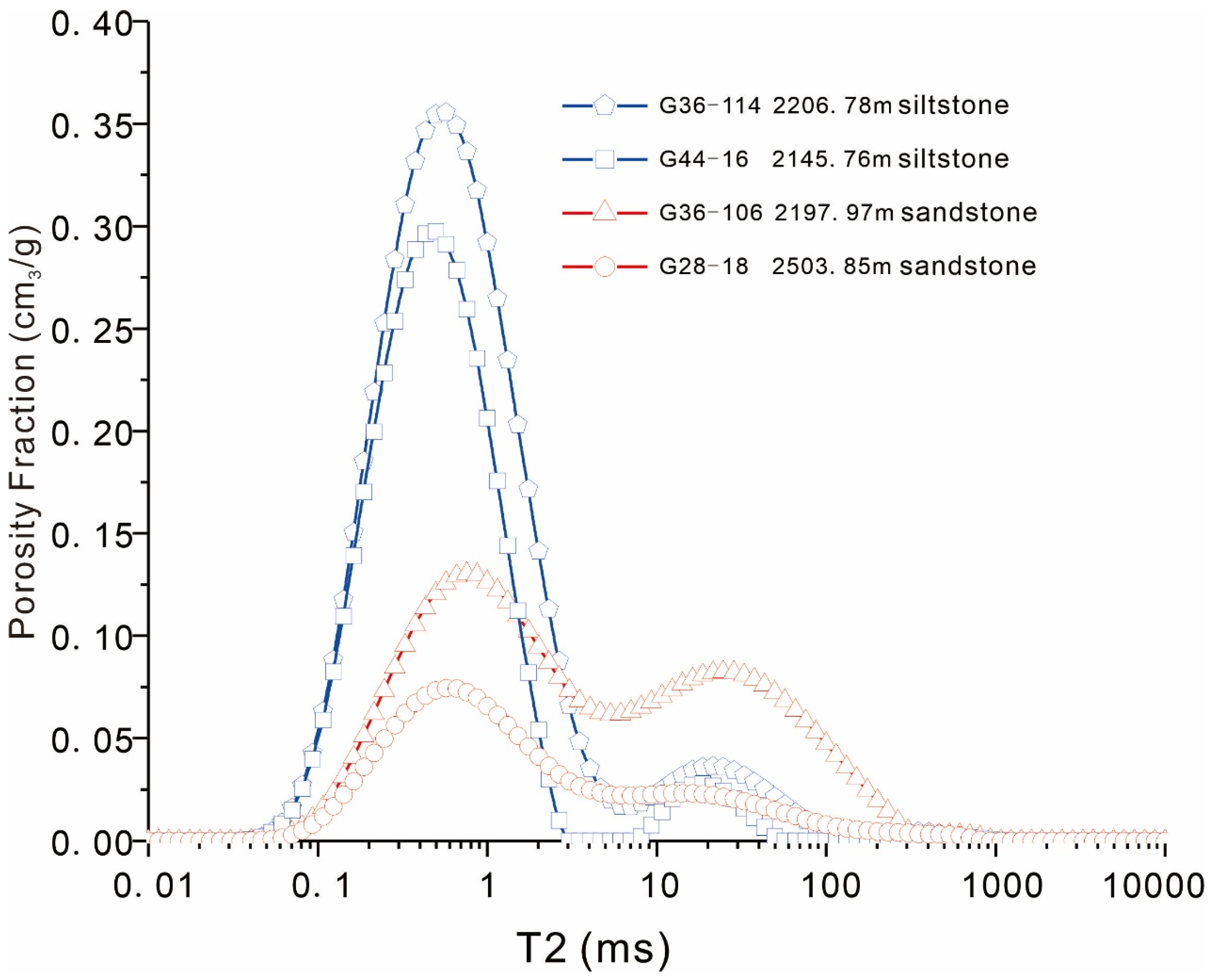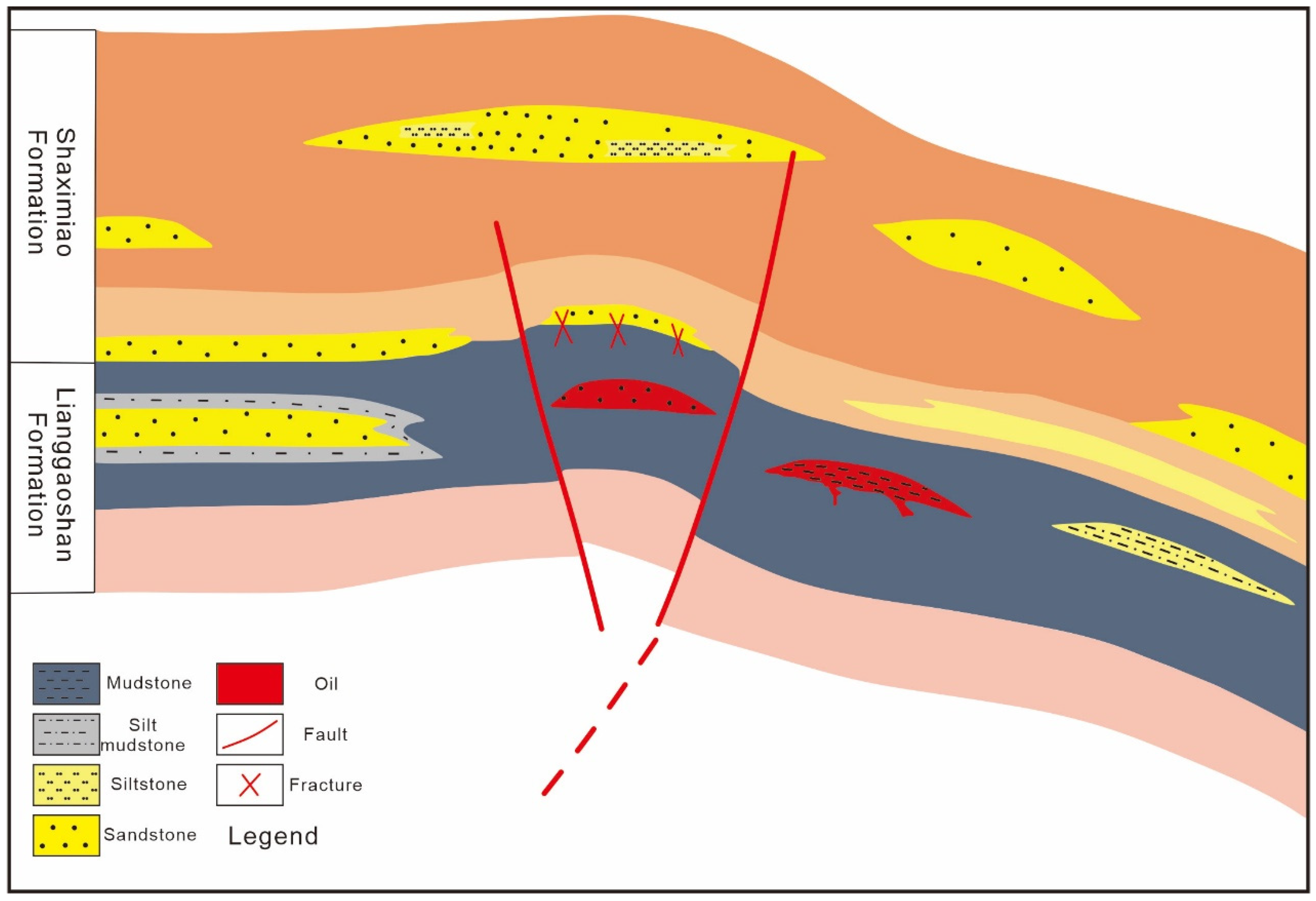1. Introduction
The Sichuan Basin is one of China’s largest oil- and gas-bearing sedimentary basins. Exploration has revealed abundant natural gas reserves in its marine strata, with reserves exceeding 15 × 10
12 m
3 [
1], but crude oil exploration remains underdeveloped. Tight oil and shale oil represent significant future exploration opportunities in the basin. Crude oil in the Sichuan Basin is primarily concentrated in Middle Jurassic Lianggaoshan and Shaximiao Formations. Although exploration began in the 1960s, no large oil fields have been discovered [
2]. In the early stage, Jurassic oil and gas exploration focused on fluvial distributary channel sandstone reservoirs, which have relatively good physical properties and are typically associated with structural traps [
3,
4]. Recent drilling has shown that, in addition to distributary channels, crude oil is also present in deltaic, beach bar, and lacustrine shale reservoirs [
5]. While much research has focused on distributary channel sandstones, shale and siltstone reservoirs remain underexplored. Moreover, Middle Jurassic reservoirs in the central Sichuan Basin exhibit high heterogeneity, with significant lateral and vertical variation [
6,
7]. Thus, understanding the reservoir characteristics of different lithologies is critical for optimizing reservoir management and developing targeted exploration strategies [
8,
9].
In this paper, sandstone, siltstone, and shale samples from multiple wells in the central Sichuan Basin were selected to compare and characterize the Middle Jurassic reservoir characteristics in detail based on XRD, scanning electron microscopy, high-pressure mercury injection, low-temperature nitrogen adsorption, and NMR analysis. The objectives of this paper include the following: (1) to compare the reservoir characteristics of different lithologies and (2) to provide a scientific basis for the next step of selecting high-quality reservoirs in the study area.
2. Geological Setting
The Sichuan Basin is an overlying sedimentary basin located in Southwestern China. It is a northeast-oriented rhomboid basin, covering an area of approximately 260,000 km
2 [
10,
11]. The basin is bounded by the Longmenshan Thrust Belt to the west, separating it from the Songpan–Ganzi Terrane; the Micangshan Uplift and Dabashan Thrust Belt to the north, separating it from the Qinling Orogenic Belt; the Jiangnan–Xuefengshan Thrust–Fold Belt to the southeast; and the Daliangshan Fold Belt to the southwest [
12,
13,
14,
15]. The basin is divided into six structural units: the Western Sichuan Depression, Northern Gentle Structural Zone, Central Uplift, Southwestern Gentle Structural Zone, Southern Gentle Structural Zone, and the Eastern Steep Structural Zone [
16,
17,
18,
19,
20] (
Figure 1a).
The evolution of the basin during the deposition of the Lianggaoshan Formation was influenced by tectonic activities from the Micang Uplift and Dabashan Thrust Belt to the north [
21]. In the early stages, the basin experienced N-S compression between the Qinling Orogenic Belt and the northern Yangtze Craton, while later stages were primarily controlled by the Hannan–Micangshan and Dabashan mountains [
14,
22,
23,
24,
25,
26,
27,
28].
Figure 1.
(
a) Middle Jurassic sedimentary facies distribution of the Sichuan Basin, SW China. (
b) Stratigraphic column of the Middle Jurassic Lianggaoshan and Shaximiao Formations in the Sichuan Basin (modified from [
29]). The study area shows the central Sichuan Basin.
Figure 1.
(
a) Middle Jurassic sedimentary facies distribution of the Sichuan Basin, SW China. (
b) Stratigraphic column of the Middle Jurassic Lianggaoshan and Shaximiao Formations in the Sichuan Basin (modified from [
29]). The study area shows the central Sichuan Basin.
The Jurassic sedimentary sequence is mainly composed of fluvial-type delta and lacustrine deposits, with a total thickness ranging from 1500 to 4000 m [
30]. The Jurassic is in parallel unconformable contact with the Cretaceous Qiqushi Formation above and the Triassic Xujiahe Formation below. The central Sichuan Basin consists of the Lower Jurassic Ziliujing Formation (J
1z), the Middle Jurassic Lianggaoshan Formation (J
2l) and Shaximiao Formation (J
2s), and the Upper Jurassic Suining Formation (J
3sn) and Penglaizhen Formation (J
3p). The Lianggaoshan Formation is subdivided into three members (J
2l
1, J
2l
2, and J
2l
3), characterized by delta and lake deposits, including a complete third-order sequence. The lithologies are primarily fluvial-type delta gray distributary channel sandstones, siltstones, and lacustrine gray-green mudstones and dark shales (
Figure 1b).
3. Methods
In this study, polarizing microscopy, scanning electron microscopy, XRD, high-pressure mercury injection, nitrogen adsorption, and nuclear magnetic resonance (NMR) were employed to analyze the reservoir characteristics of the Lianggaoshan and Shaximiao Formations in the central Sichuan Basin.
Samples of sandstone, siltstone, and shale were crushed to 200 mesh or finer. X-ray diffraction (XRD) analysis was conducted using a D/max-2500pc diffractometer (Rigaku, Tokyo, Japan). Thin-section petrography was performed using a Leica DM4500P microscope with a DFC425C camera (Beijing, China). After mechanical polishing and ion polishing, samples were gold-coated and analyzed using cold-field SEM (S-4800, Tokyo, Japan) at an acceleration voltage of 10 kV in the State Key Laboratory of Oil and Gas Reservoir Geology and Development, Chengdu University of Technology.
For high-pressure mercury intrusion, samples were cleaned of crude oil, crushed to appropriate sizes, and dried at 105 °C for 24 h. The high-pressure mercury intrusion apparatus was calibrated, and samples were subjected to evacuation, followed by gradual mercury injection to determine porosity and pore size distribution. The maximum mercury injection pressure reached 200 MPa.
For nitrogen adsorption experiments, samples were crushed to 40–60 mesh, cleaned of oil, and dried at 110 °C for 12 h before vacuum degassing. Nitrogen adsorption was measured at low temperatures using an ASAP 2460 analyzer (Micromeritics Instrument Corp, Norcross, GA, USA). Adsorption and desorption isotherms were plotted, and models such as BET and BJH were used to calculate specific surface area and pore size distribution.
For NMR analysis, the sample required pretreatment. The core samples were oil-washed and labeled, and their physical parameters (length, diameter, and weight) were measured. They were then dried in an oven at 90 °C for 12 h and placed in a desiccator to cool to room temperature. A brine solution with a salinity of 20,000 ppm was prepared, and the core samples were immersed in the brine, vacuumed, and saturated for 36 h to ensure 100% saturation. After weighing, the samples were placed in a beaker with the same brine for NMR measurement. The NMR instrument (Bruker, Bruker Billerica, MA, USA)was preheated for over 16 h to maintain the probe and magnet temperature at the experimental temperature (35 °C). A MesoMR23-060H-I NMR analyzer (Xi’an, China) was used for the measurement. The samples were placed in the measurement chamber, and the CPMG pulse sequence was employed to eliminate effects from magnetic field inhomogeneity and instrument errors. The wait time (TW) was set to 3000 ms, the echo interval (TE) to 0.3 ms, the number of echoes (NECH) to 8000, and the number of scans (NS) to 64. After setting the system acquisition parameters, the NMR T2 spectrum was measured, and the data were saved upon completion. The raw data were inverted and fitted to obtain the saturated NMR T2 spectrum.
4. Results
4.1. Petrology
In this study, distributary channel sandstone, sheet siltstone, and lacustrine shale samples from multiple wells in the central Sichuan Basin were selected. Their petrological characteristics and mineral compositions were compared through rock thin-section analysis (
Figure 2). The lithic quartz sandstone shows low-angle cross-bedding, with quartz and lithoclasts, including metamorphic rock and magmatic rock, as the main components. The grain sizes range from 0.039 to 300 μm, indicating poor sorting. The debris particles are mostly sub-rounded to sub-angular, exhibiting poor roundness (
Figure 2A). The siltstone is composed primarily of quartz, feldspar, and clay minerals. The shale and siltstone layers are interbedded, with some areas showing massive structures or horizontal lamination. The clay minerals are amorphous and exhibit a flaky distribution (
Figure 2B). The shale samples are mainly composed of quartz and clay minerals, with higher quartz contents showing well-developed horizontal lamination. Under the microscope, some laminae are filled with organic matter (
Figure 2C).
The XRD analysis indicates substantial differences in the composition of sandstone, siltstone, and shale samples from the Lianggaoshan and Shaximiao Formations (
Figure 3). Shale contains the highest percentage of clay minerals (59.1%–62.3%), such as chlorite and kaolinite (
Figure 4), followed by siltstone (33.3%–43.76%) and sandstone (14.4%–15.5%). Sandstone has the highest quartz content (83.7%–84.5%), followed by siltstone (41.6%–44.26%) and shale (29.5%–37.2%). Shale samples also contain small amounts of pyrite.
4.2. Pore Structure and Type
Sandstone is particle-supported, with well-developed intergranular pores and good connectivity. The pore diameters range from 1 to 200 μm (
Figure 4A,B). Siltstone primarily develops intercrystalline pores in microcrystalline quartz and clay mineral cements, with pore diameters less than 10 μm, though occasional intergranular pores (~10 μm) are observed (
Figure 4C,D). Shale is mainly composed of intercrystalline pores of clay minerals and organic matter, with pore diameters generally less than 100 nm (
Figure 4E,F). Overall, sandstone exhibits better-developed pores compared to siltstone, and shale has the least-developed pores.
4.3. High-Pressure Mercury Intrusion
High-pressure mercury intrusion (HPMI) is commonly used to analyze pore structure, specifically to determine the pore size distribution and volume. The method applies external pressure to force mercury into the pores, allowing measurement of the porosity of the sample. HPMI is effective for characterizing mesoporous and macroporous structures in tight reservoirs. Several sandstone, siltstone, and shale samples from the central Sichuan Basin were tested using this method. For sandstone samples, the maximum mercury saturation was 80.82%, with an average porosity of 3.155%. The mean displacement pressure was 0.7275 MPa, and the average tortuosity was 1.54. The median pore radius ranged from 0.056 to 0.06 μm, with an average throat radius of 0.15 μm. The maximum pore–throat radius ranged from 0.744 to 1.572 μm, with over 80% of the distribution between 0.05 and 0.43 μm (
Figure 5). For siltstone samples, the maximum mercury saturation was 79.68%, with an average porosity of 4.635%. The mean displacement pressure was 0.608 MPa, and the average tortuosity was 1.58. The dominant median pore radius ranged from 0.012 to 0.08 μm, with an average throat radius of 0.05 μm. The maximum pore–throat radius ranged from 0.983 to 1.574 μm, with over 80% distributed between 0.01 and 0.78 μm (
Figure 5). For shale samples, the maximum mercury saturation reached 70.86%, with an average porosity of 4.42%. The mean displacement pressure was 1.285 MPa, and the average tortuosity was 1.62. The primary median pore radius ranged from 0.005 to 0.1 μm, with an average throat radius of 0.055 μm. The maximum pore–throat radius ranged from 0.4 to 1 μm, with over 80% of the distribution concentrated between 0.006 and 0.4 μm (
Figure 5).
In summary, mercury intrusion efficiency was highest in the sandstone group, followed by the siltstone group, with the shale group exhibiting the lowest efficiency. The mercury intrusion curve for sandstone was relatively smooth and concave down, indicating a higher rate of mercury intrusion and a larger intrusion volume, reflecting a more developed pore structure in sandstone.
4.4. Low-Temperature Nitrogen Adsorption
Low-temperature nitrogen adsorption is a comprehensive method for evaluating the pore structure of core samples by analyzing adsorption isotherms and hysteresis loops (
Table S1). The BET and BJH models were used to quantitatively determine parameters such as specific surface area, total pore volume, and average pore radius. These analyses provide valuable insights into the porosity and permeability characteristics of the samples. As shown in
Figure 6, the siltstone formation exhibits an H3-type hysteresis loop, while the sandstone group shows an H4-type loop. The H3 loop, typically associated with flaky or aggregated particles, suggests a complex pore structure with open pores or fissures, allowing relatively free gas flow. A relative pressure (p/p0) of 0.46 indicates that the pore structure is partially filled with nitrogen gas, particularly in smaller pores. The H4-type hysteresis loop, common for materials with a mixed micropore and mesopore structure, indicates narrow fissures or open micropores, leading to complex gas behavior during adsorption and desorption. A relative pressure (p/p0) of 0.42 suggests that nitrogen gas begins filling smaller pores, with the material primarily consisting of micropores (less than 2 nm) and small pores (2–50 nm), the latter being more predominant.
4.5. Nuclear Magnetic Resonance (NMR)
As shown in
Figure 7, the T2 spectra of the sandstone and siltstone samples display a left-skewed bimodal distribution, with T2 values ranging from 0.01 to 10,000 ms (
Table S2). This indicates the presence of pores across a wide range of sizes. In the siltstone group, components within the 0.1–10 ms range account for a larger proportion, suggesting that the pore structure of sample G36-114 is notably tighter than that of G44-16, with both samples showing limited development of large pores and microcracks. In the sandstone group, the 0.1–10 ms component also predominates, with sample G36-106 exhibiting a greater development of large pores and microcracks compared to G28-18. The siltstone group shows a lower proportion of relaxation components greater than 10 ms, indicating a higher contribution from smaller pores.
5. Discussion
5.1. Porosity Variability in Lithology
Understanding the differences in pore types, structures, and physical properties across various lithologies in the central Sichuan Basin is critical for selecting high-quality reservoirs [
31]. Thin sections and scanning electron microscopy reveal that the pore types in sandstone reservoirs are predominantly intergranular pores, while siltstone and shale are primarily characterized by clay mineral intercrystalline pores and organic pores (
Figure 4). Overall, high-pressure mercury injection, low-temperature nitrogen adsorption, and NMR analysis indicate that macropores and mesopores are most developed in sandstone, followed by siltstone, whereas shale mainly contains micropores and small pores (
Figure 5,
Figure 6 and
Figure 7). High-pressure mercury injection curves show that micron-scale pores are more developed in sandstone and siltstone than nano-scale pores, while shale exhibits a wider range of pore sizes, which may be heavily influenced by fractures (
Figure 5). Low-temperature nitrogen adsorption reveals that siltstone has an H3-type hysteresis loop, with pore radii concentrated between 0 and 40 nm. NMR data also support this, suggesting that siltstone reservoirs are relatively tight and exhibit a complex pore structure. Notably, although sandstone reservoirs contain both micropores and mesopores, low-temperature nitrogen adsorption shows an H4-type hysteresis loop (
Figure 6), and NMR data indicate a distribution of pore sizes across different radii (
Figure 7), indicating a high degree of heterogeneity in sandstone. In summary, reservoirs of different lithologies in the central Sichuan Basin are generally tight, with sandstone reservoirs being the most favorable, followed by siltstone, and shale being the least favorable. The most likely factor causing this is that sedimentation controls reservoir properties [
26,
32]. The Jurassic central Sichuan Basin mainly develops fluvial-related deltas, in which the channel sand bodies have the best physical properties, while the suspended sedimentary siltstone and shale have the worst [
33].
5.2. Implication for Hydrocarbon Exploration and Development
While many oil fields in the central Sichuan Basin exhibit strong oil and gas, a deeper understanding of the reservoirs remains a key factor limiting exploration breakthroughs [
2]. Previous studies have predominantly focused on the Jurassic fluvial–deltaic sandstone reservoirs for reservoir characterization [
3]. Petrological analysis indicates that sandstone reservoirs have a high quartz content, which makes fracturing challenging (
Figure 3). It is generally agreed that these reservoirs are relatively tight, a conclusion consistent with the previous discussion. Consequently, exploration has historically been concentrated in areas with well-developed fractures. This study, however, supplements the characterization of siltstone and shale reservoirs. Although these are also relatively tight, earlier studies have shown that shale and siltstone reservoirs can also host fractures (
Figure 5), and source rock evaluations indicate that shale reservoirs have self-generation and self-storage potential, while siltstone reservoirs are conducive to short-distance migration and accumulation [
5,
34] (
Figure 8). Thus, siltstone and shale reservoirs modified by natural fractures present significant exploration potential and demonstrate lateral continuity. For siltstone and shale reservoirs where fractures are not well developed, crude oil can be effectively extracted through techniques such as horizontal well fracturing, as they do not possess the high quartz content characteristic of sandstone reservoirs (
Figure 3). Therefore, this study on the reservoir characterization of different lithologies in the Middle Jurassic of the central Sichuan Basin is of considerable significance for oil and gas exploration.
6. Conclusions
Comprehensive reservoir characterization studies reveal that the sandstone, siltstone, and shale reservoirs in the Middle Jurassic of the central Sichuan Basin are relatively tight, poorly connected, highly heterogeneous, and exhibit considerable variability. The pore type of sandstone is mainly intergranular pores, while that of siltstone and shale is mainly intercrystalline pores. The pore space in sandstone is the most developed, followed by siltstone, while shale has the least-developed pore space. The pore radii in sandstone primarily fall within the micrometer and nanometer ranges, while in siltstone and shale, the pore radii are mainly in the nanometer range. Due to the high quartz content in sandstone reservoirs, fracturing is challenging, making fracture-developed areas more promising for exploration. In contrast, siltstone and shale reservoirs are suitable candidates for horizontal fracturing, but they require the injection of proppant to prevent clay minerals from blocking the pores. Selecting high-quality reservoirs with favorable source–reservoir matching is essential for successful oil and gas exploration.
Author Contributions
Conceptualization, W.T.; methodology, J.L.; software, S.Z.; validation, L.D.; formal analysis, J.L.; investigation, S.Z.; resources, H.H.; data curation, K.Y.; writing—original draft preparation, C.Q.; writing—review and editing, W.T.; visualization, K.Y.; supervision, H.H.; project administration, L.D.; funding acquisition, C.Q. and W.T. All authors have read and agreed to the published version of the manuscript.
Funding
This research was supported by the Science and Technology Project of the Southwest Oil and Gas Field Company (20230301-24) to Chunyu Qin, National Natural Science Foundation of China (NSFC) Projects (No. 42202188, 42472170), and the Sichuan Science and Technology Program (No. 2023NSFSC1986), given to Wenbin Tang.
Data Availability Statement
The data presented in this study are available on request from the corresponding author. The data are not publicly available due to exploration data confidentiality.
Acknowledgments
We greatly appreciate two anonymous reviewers for their constructive comments and suggestions.
Conflicts of Interest
Chunyu Qin, Lurui Dang, Haitao Hong, and Kai Yu are employees of Exploration and Development Research Institute, PetroChina Southwest Oil and Gas Field Company. The paper reflects the views of the scientists and not the company.
References
- Dai, J.X.; Ni, Y.Y.; Liu, Q.Y.; Wu, X.Q.; Gong, D.Y.; Hong, F.; Li, H.W. Sichuan super gas basin in southwest China. Pet. Explor. Dev. 2021, 6, 1081–1088. [Google Scholar] [CrossRef]
- Zou, C.N.; Zhu, R.K.; Wu, S.T.; Yang, Z.; Tao, S.Z.; Yuan, X.J.; Wang, L. Types, characteristics, genesis and prospects of conventional and unconventional hydrocarbon accumulations: Taking tight oil and tight gas in China as an instance. Acta Pet. Sin. 2012, 2, 173–187. [Google Scholar]
- Tao, S.Z.; Yang, Y.M.; Pang, Z.L.; Yang, G.; Yang, J.J.; Yang, X.P.; Zhang, T.S. The fluid inclusion characteristics and formation, evolution of tight oil of Jurassic, Sichuan Basin. Acta Petrol. Sin. 2015, 4, 1089–1100. [Google Scholar]
- Tang, W.; Zhang, Y.; Pe-Piper, G.; Guo, Z.; Li, W. Permian to early Triassic tectono-sedimentary evolution of the Mahu sag, Junggar Basin, western China: Sedimentological implications of the transition from rifting to tectonic inversion. Mar. Pet. Geol. 2021, 123, 104730. [Google Scholar] [CrossRef]
- Zou, C.N.; Yang, Z.; Wang, H.Y.; Dong, D.Z.; Liu, H.L.; Shi, Z.S.; Yuan, Y.L. “Exploring petroleum inside source kitchen”: Jurassic unconventional continental giant shale oil & gas field in Sichuan basin, China. Acta Geol. Sin. 2019, 7, 1551–1562. [Google Scholar]
- Hussain, A.; Butt, M.N.; Olariu, C.; Malik, M.H.; Koeshidayatullah, A.; Amao, A.; Al-Ramadan, K. Unravelling reservoir quality heterogeneity in mixed siliciclastic-carbonate deposits: An example from Miocene Red Sea rift, NW Saudi Arabia. Mar. Pet. Geol. 2022, 145, 105850. [Google Scholar] [CrossRef]
- Hussain, A.; Bello, A.; Butt, M.N.; Malik, M.H.; Koeshidayatullah, A.; Amao, A.; Olariu, C.; Al-Ramadan, K. Diagenetic variability in Tertiary, syn-rift mixed siliciclastic-carbonate depositional system (Lower Musayr Formation), Red Sea, Saudi Arabia. Sediment. Geol. 2024, 470, 106699. [Google Scholar] [CrossRef]
- Tang, W.; Song, Y.; He, W.; Tang, Y.; Guo, X.; Pe-Piper, G.; Piper, D.J.; Li, W.; Guo, Z.; Zhang, Y. Source-to-sink evolution of syn-rift alkaline lake sediments in the Lower Permian Fengcheng Formation, Junggar Basin, NW China: Evidence from petrology, detrital zircon geochronology and geochemistry. J. Asian Earth Sci. 2022, 232, 105049. [Google Scholar] [CrossRef]
- Bello, A.; Butt, M.N.; Hussain, A.; Amao, A.; Olariu, C.; Koeshidayatullah, A.; Malik, M.H.; Al-Hashem, M.; Al-Ramadan, K. Impact of depositional and diagenetic controls on reservoir quality of syn-rift sedimentary systems: An example from Oligocene-Miocene Al Wajh Formation, northwest Saudi Arabia. Sediment. Geol. 2023, 470, 106342. [Google Scholar] [CrossRef]
- Li, L.Q.; Wang, Y.D.; Vajda, V. Palynofacies analysis for interpreting paleoenvironment and hydrocarbon potential of Triassic–Jurassic strata in the Sichuan Basin, China. Palaeoworld 2021, 30, 126–137. [Google Scholar] [CrossRef]
- Meng, Q.R.; Wang, E.; Hu, J.M. Mesozoic sedimentary evolution of the northwest Sichuan Basin: Implication for continued clockwise rotation of the South China block. Geol. Soc. Am. Bull. 2005, 117, 396–410. [Google Scholar] [CrossRef]
- Ma, Y.S.; Guo, X.S.; Guo, T.L.; Huang, R.; Cai, X.Y.; Li, G.X. The Puguang gas field: New giant discovery in the mature Sichuan Basin, southwest China. AAPG Bull. 2007, 91, 627–643. [Google Scholar] [CrossRef]
- Wang, Z.C.; Huang, S.P.; Gong, D.Y.; Wei, W.; Chong, Y. Geochemical characteristics of natural gases in the Upper Triassic Xujiahe Formation in the southern Sichuan Basin, SW China. Int. J. Coal Geol. 2013, 120, 15–23. [Google Scholar]
- Li, Y.Q.; He, D.F.; Li, D.; Lu, R.Q.; Fan, C.; Sun, Y.P.; Huang, H.Y. Sedimentary provenance constraints on the Jurassic to Cretaceous paleogeography of Sichuan Basin, SW China. Gondwana Res. 2018, 60, 15–33. [Google Scholar] [CrossRef]
- Tang, W.; Wang, X.; Guo, X.; He, W.; Tang, Y.; Pe-Piper, G.; Piper, D.J.; Guo, Z.; Cheng, F.; Li, W. Late Carboniferous back-arc rifting in Junggar Basin, NW China: Implication for the rapid continental growth in accretionary orogens. Int. J. Earth Sci. 2022, 111, 2493–2518. [Google Scholar] [CrossRef]
- Zhang, Y.Q.; Dong, S.W.; Li, J.H.; Shi, W. Mesozoic multi-directional compressional tectonics and formation-reformation of Sichuan basin. Geol. China 2011, 2, 233–250. [Google Scholar]
- He, W.Y.; Bai, X.F.; Meng, Q.A.; Li, J.H.; Zhang, D.Z.; Wang, Y.Z. Accumulation geological characteristies and major discoveries of lacustrine shale oil in Sichuan Basin. Acta Pet. Sin. 2022, 7, 885–898. [Google Scholar]
- Wang, X.; Wang, M.; Zhao, C.; Yang, X.Y.; Jia, Y.D.; Wu, R.; Tang, Y.L. Reservoir characteristics and controlling factors of the middle–high maturity multiple lithofacies reservoirs of the Lianggaoshan Formation shale strata in the northeastern Sichuan Basin, China. Mar. Pet. Geol. 2024, 161, 106692. [Google Scholar] [CrossRef]
- Liu, S.G.; Yang, Y.; Deng, B.; Zhong, Y.; Wen, L.; Sun, W.; Peng, H.L. Tectonic evolution of the Sichuan Basin, southwest China. Earth-Sci. Rev. 2021, 213, 103470. [Google Scholar] [CrossRef]
- Lu, Y.F.; Liang, Q.S.; Tian, J.C.; Yu, Y.; Li, Y.J.; Chen, C.Y.; Wang, D.J. Correlation and response of astronomical forcing in lacustrine deposits of the middle Jurassic, Sichuan Basin, southwest China. Mar. Pet. Geol. 2024, 166, 106905. [Google Scholar] [CrossRef]
- Tang, W.; Zhang, Y.; Pe-Piper, G.; Piper, D.J.; Guo, Z.; Li, W. Permian rifting processes in the NW Junggar Basin, China: Implications for the post-accretionary successor basins. Gondwana Res. 2021, 98, 107–124. [Google Scholar] [CrossRef]
- Yang, J.H.; Cawood, P.A.; Du, Y.S. Detrital record of mountain building: Provenance of Jurassic foreland basin to the Dabie Mountains. Tectonics 2010, 29, TC4011. [Google Scholar] [CrossRef]
- Shao, T.B.; Cheng, N.F.; Song, M.S. Provenance and tectonic-paleogeographic evolution: Constraints from detrital zircon U–Pb ages of Late Triassic-Early Jurassic deposits in the northern Sichuan Basin, central China. J. Asian Earth Sci. 2016, 127, 12–31. [Google Scholar] [CrossRef]
- Luo, L.; Qi, J.F.; Zhang, M.Z.; Wang, K.; Han, Y.Z. Detrital zircon U–Pb ages of Late Triassic–Late Jurassic deposits in the western and northern Sichuan Basin margin: Constraints on the foreland basin provenance and tectonic implications. Int. J. Earth Sci. 2014, 103, 1553–1568. [Google Scholar] [CrossRef]
- Cheng, D.W.; Zhang, Z.J.; Hong, H.T.; Zhang, S.M.; Qin, C.Y.; Yuan, X.J.; Deng, Q.J. Sequence structure, sedimentary evolution and their controlling factors of the Jurassic Lianggaoshan Formation in the East Sichuan Basin, SW China. Pet. Explor. Dev. 2023, 50, 293–305. [Google Scholar] [CrossRef]
- Hong, H.T.; Qin, C.Y.; Zhang, S.M.; Zhang, Z.J.; Wang, X.J.; Li, N.; Tang, W.B. Early–middle Jurassic source to sink evolution and its tectonic significance in the northeastern Sichuan Basin. Front. Earth Sci. 2023, 11, 1231694. [Google Scholar] [CrossRef]
- Qian, T.; Li, W.P.; Liu, S.F. Early to Middle Jurassic sedimentation within the northern Sichuan Basin in response to exhumation of the South Qinling orogenic belt, central China. Palaeogeogr. Palaeoclimatol. Palaeoecol. 2023, 630, 111805. [Google Scholar] [CrossRef]
- Huang, H.Y.; Chen, A.Q.; Li, Y.Q.; He, D.F.; Li, D.; Xu, Y.H.; Gao, J. Triassic-Jurassic evolution of the Dabashan Foreland Basin: Detrital zircon perspectives on the tectonic amalgamation of the South China and North China blocks. Palaeogeogr. Palaeoclimatol. Palaeoecol. 2024, 648, 112300. [Google Scholar] [CrossRef]
- Fang, R.; Jiang, Y.Q.; Sun, S.S.; Luo, Y.; Qi, L.; Dong, D.Z.; Jiang, Z.Z. Controlling factors of organic matter accumulation and lacustrine shale distribution in Lianggaoshan Formation, Sichuan Basin, SW China. Front. Earth Sci. 2023, 11, 1218215. [Google Scholar] [CrossRef]
- He, W.Y.; He, H.Q.; Wang, Y.H.; Cui, B.W.; Meng, Q.A.; Guo, X.J.; Wang, Y.Z. Major breakthrough and significance of shale oil exploration in the Jurassic Lianggaoshan Formation of the Sichuan Basin: Well Ping’an-1 in northeastern Sichuan. China Pet. Explor. 2022, 1, 40–49. [Google Scholar]
- Tang, W.; Pe-Piper, G.; Piper, D.J.; Chen, A.; Hou, M.; Guo, Z.; Zhang, Y. Architecture of lacustrine deposits in response to early Carboniferous rifting and Gondwanan glaciation, Nova Scotia, south-east Canada. Sedimentology 2024, 71, 457–485. [Google Scholar] [CrossRef]
- Tang, W.; Pan, S.; Pe-Piper, G.; Piper, D.J.; Zhang, Y.; Guo, Z.; Tang, Y.; Tang, W. Late Permian-Early Triassic intracontinental tectonic inversion in the Junggar Basin, NW China: New insights from detrital zircon geochronology and seismic reflection data. Basin Res. 2024, 36, e12824. [Google Scholar] [CrossRef]
- Bai, R.; Zhang, S.; Hong, H.; Qin, C.; Li, Y.; Cai, C.; Kong, X.; Li, N.; Lei, D.; Lei, X.; et al. Source-reservoir rock assemblages and hydrocarbon accumulation models in the Middle-Lower Jurassic of eastern Sichuan Basin, China. Front. Earth Sci. 2023, 11, 1207994. [Google Scholar] [CrossRef]
- Tang, W.; Zhang, Y.; Pe-Piper, D.J.; Guo, Z.; Li, W. Soft-sediment deformation structures in alkaline lake deposits of Lower Permian Fengcheng Formation, Junggar Basin, NW China: Implications for syn-sedimentary tectonic activity. Sediment. Geol. 2020, 406, 105719. [Google Scholar] [CrossRef]
| Disclaimer/Publisher’s Note: The statements, opinions and data contained in all publications are solely those of the individual author(s) and contributor(s) and not of MDPI and/or the editor(s). MDPI and/or the editor(s) disclaim responsibility for any injury to people or property resulting from any ideas, methods, instructions or products referred to in the content. |
© 2025 by the authors. Licensee MDPI, Basel, Switzerland. This article is an open access article distributed under the terms and conditions of the Creative Commons Attribution (CC BY) license (https://creativecommons.org/licenses/by/4.0/).
